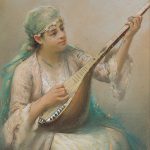İbrahim Çallı, born on November 17, 1882, in Istanbul, Ottoman Empire (modern-day Turkey), was a prominent Turkish painter who played a crucial role in the development of Turkish modern art during the late 19th and early 20th centuries. Çallı is recognized for his contributions to the transition from traditional Ottoman art to a more contemporary, Western-influenced style.
Çallı’s artistic education began at the School of Fine Arts in Istanbul (currently Mimar Sinan Fine Arts University). He later received a scholarship to study in Paris, where he enrolled at the Académie Julian, a significant hub for artistic training at the time. Exposure to European modernist movements and techniques greatly influenced Çallı’s artistic approach.
Returning to Istanbul, Çallı became a central figure in the Young Turks art movement, a group of artists advocating for the adoption of a more Western style in Turkish art. He played a key role in the establishment of the Society of Ottoman Painters, contributing to the promotion of modern artistic principles in the country.
Çallı’s early works reflected a synthesis of Western artistic techniques and traditional Ottoman themes. His paintings often depicted scenes from daily life, landscapes, and portraits, showcasing his versatility and ability to bridge different artistic traditions.
One of Çallı’s notable contributions was his involvement in the transition to a new script in Turkey. He participated in the design of the Latin alphabet, replacing the Ottoman Turkish script, as part of Mustafa Kemal Atatürk’s cultural reforms in the 1920s.
Throughout his career, Çallı continued to evolve as an artist. His later works embraced a more introspective and symbolic style, influenced by post-impressionist and expressionist tendencies. These paintings often featured allegorical themes, reflecting Çallı’s contemplation of deeper philosophical and existential questions.
İbrahim Çallı’s impact extended beyond his art. As an educator, he taught at the Academy of Fine Arts in Istanbul, contributing to the training of new generations of Turkish artists. His commitment to modernism and the development of a unique Turkish artistic identity remains influential in the country’s art history.
Çallı’s death on March 9, 1960, marked the end of a significant era in Turkish art. His legacy lives on in the continued appreciation for his contributions to the modernization of Turkish painting and the enduring influence of his ideas on the trajectory of Turkish visual arts.






